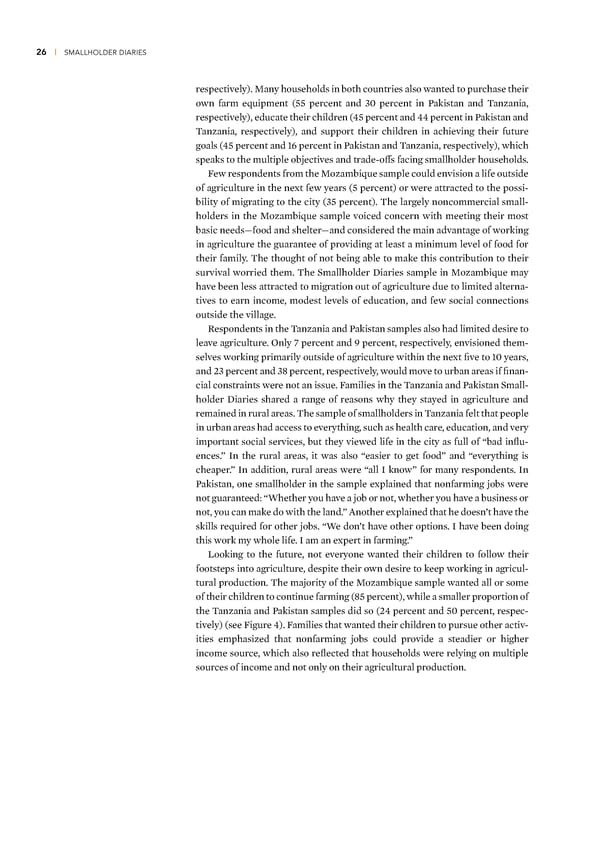26 | SMALLHOLDER DIARIES respectively) –any households in both countries also wanted to purchase their own farm euipment (”” percent and Ÿ’ percent in aistan and Œan—ania, respectively), educate their children (“” percent and ““ percent in aistan and Œan—ania, respectively), and support their children in achieving their future goals (“” percent and …¢ percent in aistan and Œan—ania, respectively), which speas to the multiple ob„ectives and trade-offs facing smallholder households ew respondents from the –o—ambiue sample could envision a life outside of agriculture in the next few years (” percent) or were attracted to the possi- bility of migrating to the city (Ÿ” percent) Œhe largely noncommercial small- holders in the –o—ambiue sample voiced concern with meeting their most basic needs—food and shelter—and considered the main advantage of woring in agriculture the guarantee of providing at least a minimum level of food for their family Œhe thought of not being able to mae this contribution to their survival worried them Œhe Smallholder ‰iaries sample in –o—ambiue may have been less attracted to migration out of agriculture due to limited alterna- tives to earn income, modest levels of education, and few social connections outside the village ªespondents in the Œan—ania and aistan samples also had limited desire to leave agriculture ¦nly • percent and ž percent, respectively, envisioned them- selves woring primarily outside of agriculture within the next five to …’ years, and ‘Ÿ percent and Ÿ¡ percent, respectively, would move to urban areas if finan- cial constraints were not an issue amilies in the Œan—ania and aistan Small- holder ‰iaries shared a range of reasons why they stayed in agriculture and remained in rural areas Œhe sample of smallholders in Œan—ania felt that people in urban areas had access to everything, such as health care, education, and very important social services, but they viewed life in the city as full of “bad influ- ences” €n the rural areas, it was also “easier to get food” and “everything is cheaper” €n addition, rural areas were “all € now” for many respondents €n aistan, one smallholder in the sample explained that nonfarming „obs were not guaranteed “™hether you have a „ob or not, whether you have a business or not, you can mae do with the land” ˆnother explained that he doesn’t have the sills reuired for other „obs “™e don’t have other options € have been doing this wor my whole life € am an expert in farming” ƒooing to the future, not everyone wanted their children to follow their footsteps into agriculture, despite their own desire to eep woring in agricul- tural production Œhe ma„ority of the –o—ambiue sample wanted all or some of their children to continue farming (¡” percent), while a smaller proportion of the Œan—ania and aistan samples did so (‘“ percent and ”’ percent, respec- tively) (see igure “) amilies that wanted their children to pursue other activ- ities emphasi—ed that nonfarming „obs could provide a steadier or higher income source, which also reflected that households were relying on multiple sources of income and not only on their agricultural production
 Financial Diaries with Smallholder Families Page 37 Page 39
Financial Diaries with Smallholder Families Page 37 Page 39